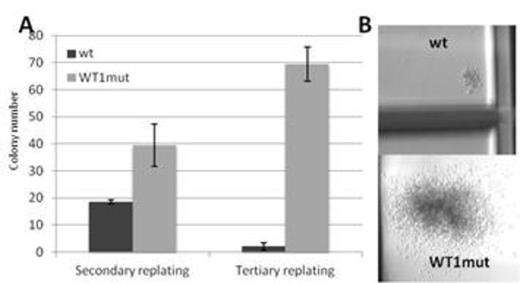Abstract
The WT1 gene encodes for a zinc finger-containing transcription factor involved in differentiation, cell cycle regulation and apoptosis. WT1 expression is developmentally regulated and tissue-specific, with expression maintained in the kidney and in CD34+ hematopoietic progenitor cells. Inactivating mutations of this tumor suppressor gene are well-described in sporadic Wilms tumor and as germline mutations in Wilms tumor predisposition syndromes. WT1 mutations have been reported in approximately 10% of both adult and pediatric patients with cytogenetically-normal acute myeloid leukemia (CN-AML), and have been associated with treatment failure and a poor prognosis. These reported mutations consist of insertions, deletions or point mutations. Many are frameshift mutations in exon 7, can occur as biallelic double mutations, and result in truncated proteins which may alter DNA-binding ability. Missense mutations in exon 9 have also been identified, and reports suggest that these may act in a dominant-negative manner, resulting in a loss of function. Despite these observations, the functional contribution of WT1 mutations to leukemogenesis is still largely undetermined.
We obtained a novel knock-in WT1 mutant mouse model, which is heterozygous for the missense mutation R394W in exon 9, and homologous to exon 9 mutations seen in human AML. We hypothesized that WT1 mutations may have an aberrant effect on hematopoiesis, and specifically, could alter progenitor cell differentiation or proliferation. To investigate this, we collected lineage-negative bone marrow (lin- BM) cells from two-month old WT1 mutant (WT1mut) and wild-type (wt) mice. We performed methylcellulose colony-forming assays, serially replating cells every 10-12 days. Strikingly, WT1mut progenitor cells showed higher in vitro colony-forming capacity and an increased ability to serially replate, suggesting aberrantly enhanced self-renewal capability. Furthermore, WT1mut colonies from secondary and tertiary passages were larger and more cohesive than wild-type colonies, demonstrating increased proliferation and morphology consistent with blast colony-forming units (CFU-blast). Flow cytometric analysis of these WT1mut cells at tertiary replating revealed an immature, largely c-Kit+ population. Next, in order to study the effects of WT1mut on HSCs in vivo, we performed serial competitive transplantation of HSC-enriched, lineage-depleted BM into lethally irradiated mice. At 14 weeks post-transplant, the donor bone marrow cells were harvested and analyzed by flow cytometry. We observed a significant expansion of the LT-HSC compartment in the WT1mut mice compared to wild-type mice. These data provide new insight into the biology and functional role of WT1 mutations in the aberrant regulation of hematopoietic stem and progenitor cell expansion.
Oncogenic WT1 mutations confer enhanced proliferation and renewal of myeloid progenitor cells in vitro and expansion of LT-HSCs in vivo. Our findings suggest that WT1 mutations enhance stem cell self-renewal, potentially priming these cells for leukemic transformation upon acquisition of cooperative events.

No relevant conflicts of interest to declare.
Author notes
Asterisk with author names denotes non-ASH members.


